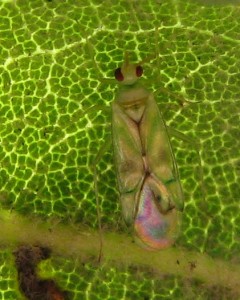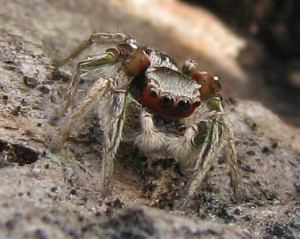We’ve added two new tiny cuties (at least we think they’re cute!) to our BFS Invert List. Harsi Parker and I spotted these at the BFS on January 16. (To be truthful, Harsi did all the spotting, photographing, and identifying. I held things for photographs.)
We found the first in a Coast Live Oak along the entry drive – a little multicolored, iridescent plant bug (Family Miridae), Paraproba hamata:
The 4-mm long P. hamata occurs along the west coast from Southern California to British Columbia, where Coast Live Oak (Quercus agrifolia) is its primary host plant. Although this species was described by Van Duzee in 1912, I could not find a single paper on its biology.
Our second find was crawling on a piece of dead wood on the south shore of pHake Lake – a tiny jumping spider (Family Salticidae), Habronattus pyrrithrix:
H. pyrrithrix is also tiny – only 5–6 mm. It’s found in Southern California, Arizona, and northwestern Mexico. While females are inconspicuously colored, males – like this one – display brilliant red faces, green legs, and white pedipalps during courtship. A recent study (Taylor et al. 2010) showed that the intensity of the red face color correlates with with good body condition, while brighter green legs correlate with poorer body condition. Our spider’s bright red face and relatively pale green legs indicate it would be good catch for any female H. pyrrithrix in the vicinity!
References:
- Van Duzee, E. P., 1912. Hemipterological gleanings. Bulletin of the Buffalo Society of Natural Sciences 10: 477-512.
- Taylor, L.A., D.L. Clark, and K. J. McGraw. 2010. Condition dependence of male display coloration in a jumping spider (Habronattus pyrrithrix). Behavioral Ecology and Sociobiology, published online 22 December 2010. [abstract]

